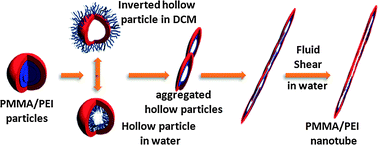The aim of this research is to elucidate the mechanism for the formation of nanotubes from hollow particles of amphiphilic graft copolymers, such as poly(ethyleneimine)-graft-poly(methyl methacrylate) (PEI-g-PMMA), under non-equilibrium conditions. The study was performed at either 15 or 17 °C with fluid shear in a mixture of dichloromethane (DCM)–water using the amphiphilic hollow particle as a building block. Effects of stirring rate and DCM to water ratio on the hollow particle assembly were systematically investigated. Surface properties and morphology of the hollow particles and the resulting assemblies in both DCM and water were characterized by X-ray photoelectron spectroscopy, scanning electron microscopy, transmission electron microscopy and atomic force microscopy. Results from these studies suggest four key features of this assembly process: (1) morphology of the amphiphilic hollow particle can be inverted in organic solvent and water. (2) The assembly process can only occur with appropriate fluid shear and DCM : water ratio. (3) The hollow particles can undergo deformation to ellipsoidal shapes with stirring rate at 350 rpm in an appropriate DCM : water (e.g. 3 : 7 v/v) mixture. (4) The elongated hollow particles then assemble to form linear aggregates via tip-to-tip connection, followed by coalescence and fusion to generate nanotubes with diameters less than 150 nm. The lengths of the nanotubes can be up to micron-scale, and they can be easily aligned via a simple dip-coating method. This simple and inexpensive assembly process using amphiphilic hollow particles as a building blocks is dramatically different from the well-known self-assembly of block copolymers into different nanostructures under equilibrium conditions.

You have access to this article
 Please wait while we load your content...
Something went wrong. Try again?
Please wait while we load your content...
Something went wrong. Try again?


 Please wait while we load your content...
Please wait while we load your content...